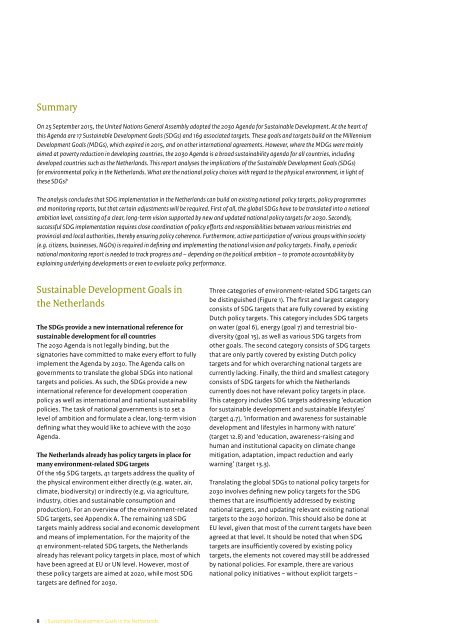Sustainable Development Goals in the Netherlands
pbl-2016-sustainable-development-in-the-Netherlands_1966
pbl-2016-sustainable-development-in-the-Netherlands_1966
Create successful ePaper yourself
Turn your PDF publications into a flip-book with our unique Google optimized e-Paper software.
<br />
Summary<br />
On 25 September 2015, <strong>the</strong> United Nations General Assembly adopted <strong>the</strong> 2030 Agenda for <strong>Susta<strong>in</strong>able</strong> <strong>Development</strong>. At <strong>the</strong> heart of<br />
this Agenda are 17 <strong>Susta<strong>in</strong>able</strong> <strong>Development</strong> <strong>Goals</strong> (SDGs) and 169 associated targets. These goals and targets build on <strong>the</strong> Millennium<br />
<strong>Development</strong> <strong>Goals</strong> (MDGs), which expired <strong>in</strong> 2015, and on o<strong>the</strong>r <strong>in</strong>ternational agreements. However, where <strong>the</strong> MDGs were ma<strong>in</strong>ly<br />
aimed at poverty reduction <strong>in</strong> develop<strong>in</strong>g countries, <strong>the</strong> 2030 Agenda is a broad susta<strong>in</strong>ability agenda for all countries, <strong>in</strong>clud<strong>in</strong>g<br />
developed countries such as <strong>the</strong> Ne<strong>the</strong>rlands. This report analyses <strong>the</strong> implications of <strong>the</strong> <strong>Susta<strong>in</strong>able</strong> <strong>Development</strong> <strong>Goals</strong> (SDGs)<br />
for environmental policy <strong>in</strong> <strong>the</strong> Ne<strong>the</strong>rlands. What are <strong>the</strong> national policy choices with regard to <strong>the</strong> physical environment, <strong>in</strong> light of<br />
<strong>the</strong>se SDGs?<br />
The analysis concludes that SDG implementation <strong>in</strong> <strong>the</strong> Ne<strong>the</strong>rlands can build on exist<strong>in</strong>g national policy targets, policy programmes<br />
and monitor<strong>in</strong>g reports, but that certa<strong>in</strong> adjustments will be required. First of all, <strong>the</strong> global SDGs have to be translated <strong>in</strong>to a national<br />
ambition level, consist<strong>in</strong>g of a clear, long-term vision supported by new and updated national policy targets for 2030. Secondly,<br />
successful SDG implementation requires close coord<strong>in</strong>ation of policy efforts and responsibilities between various m<strong>in</strong>istries and<br />
prov<strong>in</strong>cial and local authorities, <strong>the</strong>reby ensur<strong>in</strong>g policy coherence. Fur<strong>the</strong>rmore, active participation of various groups with<strong>in</strong> society<br />
(e.g. citizens, bus<strong>in</strong>esses, NGOs) is required <strong>in</strong> def<strong>in</strong><strong>in</strong>g and implement<strong>in</strong>g <strong>the</strong> national vision and policy targets. F<strong>in</strong>ally, a periodic<br />
national monitor<strong>in</strong>g report is needed to track progress and – depend<strong>in</strong>g on <strong>the</strong> political ambition – to promote accountability by<br />
expla<strong>in</strong><strong>in</strong>g underly<strong>in</strong>g developments or even to evaluate policy performance.<br />
<strong>Susta<strong>in</strong>able</strong> <strong>Development</strong> <strong>Goals</strong> <strong>in</strong><br />
<strong>the</strong> Ne<strong>the</strong>rlands<br />
The SDGs provide a new <strong>in</strong>ternational reference for<br />
susta<strong>in</strong>able development for all countries<br />
The 2030 Agenda is not legally b<strong>in</strong>d<strong>in</strong>g, but <strong>the</strong><br />
signatories have committed to make every effort to fully<br />
implement <strong>the</strong> Agenda by 2030. The Agenda calls on<br />
governments to translate <strong>the</strong> global SDGs <strong>in</strong>to national<br />
targets and policies. As such, <strong>the</strong> SDGs provide a new<br />
<strong>in</strong>ternational reference for development cooperation<br />
policy as well as <strong>in</strong>ternational and national susta<strong>in</strong>ability<br />
policies. The task of national governments is to set a<br />
level of ambition and formulate a clear, long-term vision<br />
def<strong>in</strong><strong>in</strong>g what <strong>the</strong>y would like to achieve with <strong>the</strong> 2030<br />
Agenda.<br />
The Ne<strong>the</strong>rlands already has policy targets <strong>in</strong> place for<br />
many environment-related SDG targets<br />
Of <strong>the</strong> 169 SDG targets, 41 targets address <strong>the</strong> quality of<br />
<strong>the</strong> physical environment ei<strong>the</strong>r directly (e.g. water, air,<br />
climate, biodiversity) or <strong>in</strong>directly (e.g. via agriculture,<br />
<strong>in</strong>dustry, cities and susta<strong>in</strong>able consumption and<br />
production). For an overview of <strong>the</strong> environment-related<br />
SDG targets, see Appendix A. The rema<strong>in</strong><strong>in</strong>g 128 SDG<br />
targets ma<strong>in</strong>ly address social and economic development<br />
and means of implementation. For <strong>the</strong> majority of <strong>the</strong><br />
41 environment-related SDG targets, <strong>the</strong> Ne<strong>the</strong>rlands<br />
already has relevant policy targets <strong>in</strong> place, most of which<br />
have been agreed at EU or UN level. However, most of<br />
<strong>the</strong>se policy targets are aimed at 2020, while most SDG<br />
targets are def<strong>in</strong>ed for 2030.<br />
Three categories of environment-related SDG targets can<br />
be dist<strong>in</strong>guished (Figure 1). The first and largest category<br />
consists of SDG targets that are fully covered by exist<strong>in</strong>g<br />
Dutch policy targets. This category <strong>in</strong>cludes SDG targets<br />
on water (goal 6), energy (goal 7) and terrestrial biodiversity<br />
(goal 15), as well as various SDG targets from<br />
o<strong>the</strong>r goals. The second category consists of SDG targets<br />
that are only partly covered by exist<strong>in</strong>g Dutch policy<br />
targets and for which overarch<strong>in</strong>g national targets are<br />
currently lack<strong>in</strong>g. F<strong>in</strong>ally, <strong>the</strong> third and smallest category<br />
consists of SDG targets for which <strong>the</strong> Ne<strong>the</strong>rlands<br />
currently does not have relevant policy targets <strong>in</strong> place.<br />
This category <strong>in</strong>cludes SDG targets address<strong>in</strong>g ‘education<br />
for susta<strong>in</strong>able development and susta<strong>in</strong>able lifestyles’<br />
(target 4.7), ‘<strong>in</strong>formation and awareness for susta<strong>in</strong>able<br />
development and lifestyles <strong>in</strong> harmony with nature’<br />
(target 12.8) and ‘education, awareness-rais<strong>in</strong>g and<br />
human and <strong>in</strong>stitutional capacity on climate change<br />
mitigation, adaptation, impact reduction and early<br />
warn<strong>in</strong>g’ (target 13.3).<br />
Translat<strong>in</strong>g <strong>the</strong> global SDGs to national policy targets for<br />
2030 <strong>in</strong>volves def<strong>in</strong><strong>in</strong>g new policy targets for <strong>the</strong> SDG<br />
<strong>the</strong>mes that are <strong>in</strong>sufficiently addressed by exist<strong>in</strong>g<br />
national targets, and updat<strong>in</strong>g relevant exist<strong>in</strong>g national<br />
targets to <strong>the</strong> 2030 horizon. This should also be done at<br />
EU level, given that most of <strong>the</strong> current targets have been<br />
agreed at that level. It should be noted that when SDG<br />
targets are <strong>in</strong>sufficiently covered by exist<strong>in</strong>g policy<br />
targets, <strong>the</strong> elements not covered may still be addressed<br />
by national policies. For example, <strong>the</strong>re are various<br />
national policy <strong>in</strong>itiatives – without explicit targets –<br />
8 | <strong>Susta<strong>in</strong>able</strong> <strong>Development</strong> <strong>Goals</strong> <strong>in</strong> <strong>the</strong> Ne<strong>the</strong>rlands


